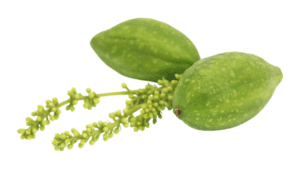Introduction
Terminalia bellirica Roxb. belongs to the family Combretaceae and is found widely though out India, Srilanka, and Southeast Asia. This plan is successfully used for medicinal purp[ose from ancient times. It is a tall handsome tree about 12-50 m tall and with unique bark.
Botanical description

Height
It is a large deciduous tree up to 50 m tall with a diameter of 3 m and a rounded crown (1).
Leaves
The leaves of Baheda (Terminalia bellirica) are 8-20 cm long and 7.5 -15 cm wide with 2 cm stalks. They are alternately arranged at the end of branches, elliptic obovate, dotted, and the entire leaf tip is narrow-pointed or rounded.
Bark
Blue or ash gray in color and covered with numerous fine cracks. The interior of the bark is yellow in color.
Flowers
The flowers are solitary and small 3-15 cm and greenish-yellow in color, stalkless, upper flowers of the spike are male and the lower flowers are bisexual. these flowers are having a strong honey-like smell.
Fruits
Are sub-globular to broadly ellipsoid with 1.5-2 cm in diameter. Light yellow in color and stone very thick, indistinctly 5-angled.
Main components found in Baheda (Terminalia bellirica)
1. Fruits
The fruits of this plants are rich in Tain termilignan, thannilignan, flavones, gallic acid, ellagic acid, and beta-sitosterol
2. Seeds
It contain cardenolide, cannogenol, sed oil
3. Stem bark
Mainly has Arjungenin and its glycosides, belleric acid, and bellericosides (2).
Baheda (Terminalia bellirica) benefits
The fruits of these plants are laxative in nature. Also used for hyperlipidemia (treats blood lipid levels) and digestive disorders like diarrhea, constipation, and indigestion. Used orally for the treatment of liver and respiratory issues including respiratory tract infection, cough, cold and sore throat (3).
Baheda fruits benefits
Fruits are astringents that are sour or bitter in taste and thus help in healing minor abrasions.
Treats hepatitis that helps in reducing the inflammation of the liver.
also treats bronchitis, asthma, cough, hoarseness of voice, and respiratory tract infections (2).
Benefits of Leaves of Baheda
The leaves enhance appetite, relieves piles, and lowers cholesterol level and blood pressure. It also helps in boosting immunity and slows down the process of aging (4).
Baheda seeds benefits
Seeds are used as an aphrodisiac, the oil extracted from the seeds is used in leucoderma and alopecia and also has a laxative effect (5 & 6).
Other health benefits of Baheda (Terminalia bellirica)
1. Antidepressant activity
Water and ethanolic extract of Baheda (Terminalia bellirica) possess antidepressant activity. Studies done on animal model proves that plant helps in lowering depression by interacting with adrenergic, dopaminergic, and serotonergic systems (7).
2. Treats cardiovascular disease
Studies show that the ethanolic extract of the leaf of Baheda (Terminalia bellirica) exhibits angiogenic activity in animal models (8).
3. Wound healing activity
The herbal paste of Baheda (Terminalia bellirica) helps in healing the wound by improving wound contraction and epithelization (9).
4. Antiulcer activity
The ethanolic extract of the plant helps in reducing the ulcer index acidity and thus acts as an antiulcer (10).
5. Prevents diarrhea
The fruit pulp of Baheda (Terminalia bellirica) is having antisecretory effects thus the water extract of the fruit pulp helps in preventing diarrhea (11).
6. Antioxidant activity
The fruits of this plant contain enzymatic and nonenzymatic constituents and thus are very effective against microbes causing various diseases. It is also a potential source of antioxidants and thus is helpful in treating diseases like cancer, coronary heart disease, aging, etc (12).
Miracal combination of triphala
Fruits of Baheda (Terminalia bellirica) are used as a health harmonizer in combination with Terminalia chebula and Emblica officinalis in traditional Ayurvedic systems. Popularly known as Triphala churna or powder good in lowering cholesterol levels and also prevents the necrosis of cardiac tissue.
Terminalia bellirica and Terminalia chebula are also used in combination for the treatment of hyperlipidemia and digestive disorders like diarrhea, constipation, and indigestion.
